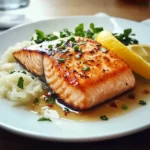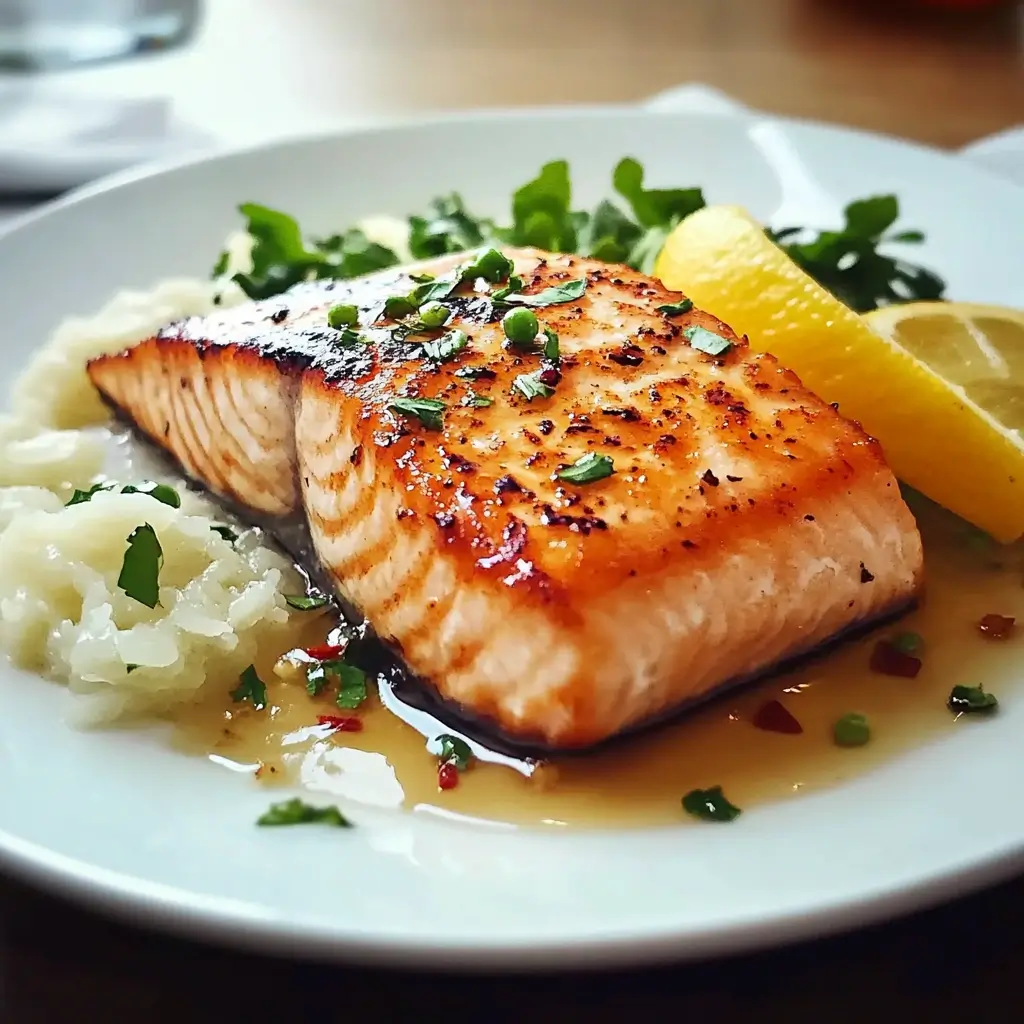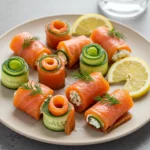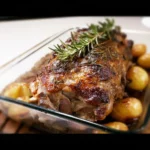From the moment I first tried this pan-seared salmon recipe, it became an instant weeknight staple in our home. The simplicity of the preparation, combined with the incredible flavor and flaky texture of the salmon, is truly unmatched. Even my picky eaters, who sometimes turn their noses up at fish, devoured every last bite. The crispy skin, achieved with just a few simple steps, adds a delightful textural contrast to the tender, melt-in-your-mouth flesh. Whether you’re a seasoned cook or just starting out, this recipe is foolproof and delivers restaurant-quality results in minutes. It’s healthy, delicious, and incredibly versatile, making it the perfect centerpiece for a quick family dinner or a more elegant meal. Trust me, once you try this method, pan-seared salmon will become your go-to fish dish.
Ingredients for Perfectly Pan-Seared Salmon
To create truly exceptional pan-seared salmon, the quality of your ingredients matters. While the list is short and sweet, each component plays a crucial role in the final dish. Let’s break down each ingredient and discuss why it’s important and what to look for:
- Salmon Fillets: The star of the show! For pan-searing, aim for salmon fillets that are roughly the same thickness to ensure even cooking. Skin-on fillets are highly recommended as the skin becomes wonderfully crispy and adds a layer of flavor and texture. When choosing salmon, consider the following:
- Freshness: Fresh salmon should have a vibrant color, a firm texture, and a mild, ocean-like scent. Avoid salmon that smells overly fishy or has a dull, dry appearance. If purchasing from a fish counter, don’t hesitate to ask when the salmon arrived and if it was previously frozen.
- Type of Salmon: There are various types of salmon, each with slightly different flavor profiles and fat content.
- King (Chinook) Salmon: Often considered the highest quality, King salmon is rich in flavor and has a high fat content, making it incredibly moist and flavorful when pan-seared. It’s typically more expensive.
- Sockeye Salmon: Known for its deep red color and robust, slightly “fishier” flavor, Sockeye salmon is leaner than King but still holds up well to pan-searing.
- Coho (Silver) Salmon: Milder in flavor than Sockeye and King, Coho salmon is a good all-around choice and a bit more affordable.
- Pink Salmon: The most common and least expensive type, Pink salmon is the leanest and has the mildest flavor. While it can be pan-seared, it’s best to be careful not to overcook it as it can become dry.
- Atlantic Salmon (Farmed): Most Atlantic salmon is farmed. Farmed salmon tends to be higher in fat than wild salmon and has a milder flavor. It’s generally a more budget-friendly option and is readily available.
- Wild vs. Farmed: The choice between wild and farmed salmon is a matter of personal preference, budget, and sustainability concerns. Wild salmon is often lauded for its richer flavor and potential health benefits, while farmed salmon is generally more affordable and consistently available. Both can be delicious when pan-seared.
- Skin Preparation: Ensure the salmon fillets are properly scaled. Most fishmongers will do this, but double-check. You can ask them to remove the pin bones as well for easier eating.
- Olive Oil (or Avocado Oil): A good quality oil is essential for pan-searing. Olive oil, especially extra virgin olive oil, adds flavor and helps the salmon skin crisp up beautifully. Avocado oil is another excellent option with a high smoke point and neutral flavor, making it ideal for high-heat cooking. You can also use other oils with high smoke points like canola oil or grapeseed oil, but olive oil and avocado oil are preferred for their flavor and health benefits.
- Salt: Kosher salt or sea salt is recommended. Salt enhances the flavor of the salmon and helps to draw out moisture, resulting in crispier skin. Don’t be shy with the salt – properly seasoning is crucial for delicious salmon.
- Black Pepper: Freshly ground black pepper adds a touch of spice and complexity to the salmon. Coarsely ground pepper provides a more noticeable flavor and texture.
- Lemon (Optional but Highly Recommended): Fresh lemon juice brightens the flavor of the salmon and adds a lovely citrusy note. Lemon wedges for serving are also a must.
- Fresh Herbs (Optional): Fresh herbs like dill, parsley, thyme, or rosemary can elevate the flavor of pan-seared salmon. Finely chopped herbs can be added before or after cooking. Dill and lemon are a classic pairing with salmon.
Detailed Ingredient List:
- 2 (6-8 ounce) salmon fillets, skin-on, scaled and pin bones removed
- 2 tablespoons olive oil or avocado oil
- 1 teaspoon kosher salt, plus more to taste
- ½ teaspoon freshly ground black pepper, plus more to taste
- 1 tablespoon fresh lemon juice (optional, but recommended)
- Lemon wedges, for serving
- Fresh herbs (dill, parsley, thyme, or rosemary), finely chopped (optional, for garnish)
Step-by-Step Instructions for Perfect Pan-Seared Salmon
Pan-searing salmon to perfection is all about technique and attention to detail. Follow these step-by-step instructions to achieve crispy skin and moist, flaky salmon every time.
Step 1: Prepare the Salmon
- Pat Dry: This is perhaps the most crucial step for crispy skin. Use paper towels to thoroughly pat both sides of the salmon fillets completely dry. Removing excess moisture is essential for achieving a good sear. Don’t skip this step!
- Season Generously: Season both sides of the salmon fillets generously with salt and freshly ground black pepper. Don’t be afraid to season well – this is your opportunity to build flavor. If using, drizzle the lemon juice over the flesh side of the salmon and let it sit for a few minutes while you prepare the pan.
Step 2: Heat the Pan
- Choose the Right Pan: A heavy-bottomed skillet is ideal for pan-searing. Cast iron, stainless steel, or a heavy non-stick skillet will work well. Cast iron retains heat exceptionally well and is excellent for achieving a crispy sear.
- Heat the Oil: Place the skillet over medium-high heat. Add the olive oil or avocado oil to the pan. Let the oil heat up until it shimmers and is just about to smoke. This is important – you want the pan and oil to be hot before adding the salmon to ensure a good sear and prevent sticking. A properly heated pan is key to preventing the salmon from sticking and achieving that coveted crispy skin.
Step 3: Sear the Salmon Skin-Side Down
- Carefully Place Salmon: Once the oil is hot, gently place the salmon fillets skin-side down in the hot pan. If using multiple fillets, make sure not to overcrowd the pan, as this can lower the temperature and prevent proper searing. If necessary, cook the salmon in batches.
- Don’t Move It! Resist the urge to move or flip the salmon immediately. Let it sear undisturbed for 4-6 minutes, depending on the thickness of the fillet and the heat of your pan. You should hear a vigorous sizzle and see the skin starting to crisp and turn golden brown. This undisturbed searing is what creates the crispy skin.
- Check for Crispy Skin: After about 4 minutes, carefully lift a corner of one fillet with a spatula to check the skin. It should be golden brown and crispy. If it’s not yet crispy, continue searing for another minute or two.
Step 4: Flip and Finish Cooking
- Flip Gently: Once the skin is crispy and golden brown, carefully flip the salmon fillets using a thin spatula. Be gentle to avoid tearing the skin.
- Reduce Heat (Optional): If your pan is getting too hot and the salmon is browning too quickly, you can reduce the heat to medium.
- Cook to Desired Doneness: Continue cooking the salmon flesh-side down for another 2-4 minutes, or until the salmon is cooked through to your desired doneness. The cooking time will depend on the thickness of the fillets and your preference.
- Medium-Rare: For medium-rare salmon, the center will still be slightly translucent and moist. The internal temperature should reach around 125-130°F (52-54°C).
- Medium: For medium salmon, the center will be mostly opaque but still moist. The internal temperature should reach around 130-135°F (54-57°C).
- Well-Done: For well-done salmon, the fish will be opaque throughout. The internal temperature should reach around 145°F (63°C). However, be careful not to overcook salmon, as it can become dry.
- Use a Thermometer (Recommended): The best way to ensure perfectly cooked salmon is to use an instant-read thermometer. Insert the thermometer into the thickest part of the fillet to check the internal temperature.
Step 5: Rest and Serve
- Remove from Pan: Once the salmon is cooked to your desired doneness, carefully remove it from the pan and place it on a plate or cutting board.
- Rest Briefly: Let the salmon rest for 2-3 minutes before serving. This allows the juices to redistribute, resulting in more tender and flavorful salmon. Don’t skip the resting step!
- Garnish and Serve: Garnish with fresh herbs, if desired, and serve immediately with lemon wedges. Squeeze fresh lemon juice over the salmon just before serving for a bright and fresh flavor.
Nutrition Facts for Pan-Seared Salmon
(Note: Nutritional information is approximate and can vary based on specific ingredients and portion sizes. This is an estimate based on a 6-ounce serving of salmon, cooked with 1 tablespoon of olive oil.)
Serving Size: 1 Salmon Fillet (approximately 6 ounces cooked)
Servings Per Recipe: 2
Approximate Nutrition Facts Per Serving:
- Calories: 450-550 kcal
- Protein: 40-50 grams
- Fat: 30-40 grams
- Saturated Fat: 5-7 grams
- Monounsaturated Fat: 15-20 grams
- Polyunsaturated Fat: 8-12 grams (including Omega-3 Fatty Acids)
- Cholesterol: 120-150 mg
- Sodium: 500-700 mg (depending on salt added)
- Carbohydrates: 0 grams
- Fiber: 0 grams
- Sugar: 0 grams
Key Nutritional Highlights:
- Excellent Source of Protein: Salmon is a powerhouse of high-quality protein, essential for muscle building, repair, and overall health.
- Rich in Omega-3 Fatty Acids: Salmon is one of the best sources of Omega-3 fatty acids, particularly EPA and DHA. These healthy fats are crucial for heart health, brain function, and reducing inflammation.
- Good Source of Vitamins and Minerals: Salmon provides vitamins D and B12, as well as selenium, potassium, and other essential nutrients.
- Relatively Low in Calories and Carbohydrates: Pan-seared salmon is a relatively low-calorie and carbohydrate-free meal option, making it suitable for various dietary needs.
Preparation Time for Pan-Seared Salmon
This recipe is known for its speed and simplicity, making it perfect for busy weeknights.
- Prep Time: 5-10 minutes (This includes patting the salmon dry, seasoning it, and gathering your ingredients.)
- Cook Time: 8-10 minutes (Pan-searing takes just a few minutes per side, depending on the thickness of your salmon and desired doneness.)
- Total Time: 13-20 minutes
From start to finish, you can have perfectly pan-seared salmon on the table in under 20 minutes! This makes it an incredibly efficient and delicious meal option.
How to Serve Pan-Seared Salmon
Pan-seared salmon is incredibly versatile and pairs well with a wide variety of side dishes and sauces. Here are some delicious serving suggestions to create a complete and satisfying meal:
Vegetable Sides:
- Roasted Asparagus: A classic pairing! Roast asparagus with olive oil, salt, and pepper for a simple and healthy side.
- Steamed or Sautéed Green Beans: Green beans are quick and easy to prepare and complement salmon beautifully.
- Broccoli or Broccolini: Roasted, steamed, or sautéed broccoli or broccolini are nutritious and flavorful choices.
- Garlic Parmesan Spinach: Sautéed spinach with garlic and Parmesan cheese adds richness and flavor.
- Roasted Brussels Sprouts: Crispy roasted Brussels sprouts offer a slightly sweet and nutty flavor that pairs well with salmon.
- Simple Salad: A fresh green salad with a light vinaigrette provides a refreshing contrast to the richness of the salmon.
Grain and Starchy Sides:
- Quinoa: A healthy and protein-rich grain that makes a great base for salmon.
- Rice (White or Brown): Steamed rice, especially brown rice, is a versatile and satisfying side.
- Roasted Potatoes: Roasted potatoes, whether simple or seasoned, are a classic and comforting side dish.
- Mashed Sweet Potatoes: Sweet potatoes offer a touch of sweetness and are packed with nutrients.
- Couscous: Light and fluffy couscous is a quick-cooking grain that pairs well with salmon.
Sauces and Toppings:
- Lemon Butter Sauce: A classic sauce for salmon! Melt butter with lemon juice, garlic, and herbs for a rich and flavorful sauce.
- Dill Sauce: A creamy dill sauce made with yogurt or sour cream, fresh dill, and lemon juice is a refreshing and traditional pairing.
- Chimichurri Sauce: A vibrant Argentinian sauce made with parsley, cilantro, garlic, olive oil, and vinegar adds a zesty and herbaceous flavor.
- Mango Salsa: A sweet and spicy mango salsa provides a tropical twist and complements the richness of the salmon.
- Avocado Crema: A creamy avocado crema made with avocado, lime juice, cilantro, and a touch of jalapeño adds richness and freshness.
- Simply Lemon Wedges: Sometimes, all you need is a squeeze of fresh lemon juice to enhance the natural flavor of the salmon.
Complete Meal Ideas:
- Salmon with Roasted Asparagus and Lemon Butter Sauce: A classic and elegant combination.
- Salmon with Quinoa and Steamed Broccoli: A healthy and balanced meal.
- Salmon Salad with Mixed Greens and Vinaigrette: A lighter and refreshing option.
- Salmon Tacos with Mango Salsa and Avocado Crema: A fun and flavorful twist on salmon.
- Salmon with Roasted Potatoes and Green Beans: A comforting and family-friendly meal.
Additional Tips for Perfect Pan-Seared Salmon
Mastering pan-seared salmon is easier than you think with these helpful tips:
- Start with Dry Salmon: As mentioned earlier, patting the salmon fillets completely dry with paper towels is paramount for achieving crispy skin. Moisture is the enemy of crispiness!
- Hot Pan, Hot Oil: Ensure your skillet and oil are properly heated before adding the salmon. A hot pan is essential for searing and preventing sticking. The oil should shimmer and be just about to smoke.
- Don’t Overcrowd the Pan: If cooking multiple fillets, avoid overcrowding the pan. Overcrowding lowers the pan temperature and steams the salmon instead of searing it. Cook in batches if necessary to maintain a hot pan and ensure proper searing.
- Resist the Urge to Move It: Once the salmon is in the pan, resist the urge to move it around or flip it too early. Let it sear undisturbed skin-side down for at least 4-5 minutes to develop that crispy skin. Patience is key!
- Use a Thermometer for Doneness: The most accurate way to determine if salmon is cooked to perfection is to use an instant-read thermometer. Insert it into the thickest part of the fillet to check the internal temperature. Aim for 125-130°F for medium-rare, 130-135°F for medium, and 145°F for well-done (though well-done is generally not recommended for optimal texture).
Frequently Asked Questions (FAQ) About Pan-Seared Salmon
Q1: How do I know when my pan-seared salmon is cooked perfectly?
A: The best way to ensure perfectly cooked salmon is to use an instant-read thermometer. Insert the thermometer into the thickest part of the fillet. For medium-rare, aim for 125-130°F (52-54°C); for medium, 130-135°F (54-57°C); and for well-done, 145°F (63°C). You can also visually check for doneness. Cooked salmon will flake easily when gently pressed with a fork and will transition from translucent to opaque.
Q2: How do I get crispy skin on pan-seared salmon?
A: Achieving crispy salmon skin comes down to a few key factors:
- Dry Salmon: Pat the salmon fillets completely dry with paper towels before seasoning.
- Hot Pan and Oil: Ensure your skillet and oil are properly heated before adding the salmon.
- Skin-Side Down First: Always start searing skin-side down and let it cook undisturbed for at least 4-5 minutes.
- Don’t Overcrowd: Avoid overcrowding the pan, as this can steam the salmon instead of searing it.
Q3: Can I use frozen salmon for pan-searing?
A: Yes, you can use frozen salmon, but it’s best to thaw it completely before pan-searing. Thaw frozen salmon in the refrigerator overnight or use the quick-thaw method by placing it in a sealed bag and submerging it in cold water. Make sure to pat it very dry after thawing, as frozen salmon tends to release more moisture. Fresh salmon is generally preferred for optimal texture and flavor, but properly thawed frozen salmon can still yield delicious results.
Q4: What type of oil is best for pan-searing salmon?
A: Oils with a high smoke point are best for pan-searing. Excellent choices include:
- Avocado Oil: High smoke point and neutral flavor.
- Olive Oil (Light or Refined): Light or refined olive oil has a higher smoke point than extra virgin olive oil and is suitable for pan-searing. Extra virgin olive oil can also be used but be careful not to overheat it.
- Canola Oil: Neutral flavor and high smoke point.
- Grapeseed Oil: Neutral flavor and high smoke point.
While butter can add flavor, it has a lower smoke point and is more likely to burn at high searing temperatures. You can use a combination of oil and butter, adding the butter towards the end of cooking for flavor.
Q5: How can I add more flavor to my pan-seared salmon?
A: There are many ways to enhance the flavor of pan-seared salmon beyond just salt and pepper:
- Marinades: Marinate salmon for 30 minutes to an hour in a mixture of lemon juice, herbs, garlic, soy sauce, or other flavorings before pan-searing.
- Herb Crust: Press chopped fresh herbs onto the flesh side of the salmon before searing.
- Spice Rubs: Use spice rubs made with paprika, garlic powder, onion powder, chili powder, or other spices.
- Sauces: Serve pan-seared salmon with flavorful sauces like lemon butter sauce, dill sauce, chimichurri, or mango salsa.
- Garnishes: Garnish with fresh herbs, lemon wedges, or a sprinkle of flaky sea salt after cooking.
Experiment with different flavors and seasonings to find your favorite way to enjoy pan-seared salmon!
Print
Pan-Seared Salmon Recipe
Ingredients
- 2 (6-8 ounce) salmon fillets, skin-on, scaled and pin bones removed
- 2 tablespoons olive oil or avocado oil
- 1 teaspoon kosher salt, plus more to taste
- ½ teaspoon freshly ground black pepper, plus more to taste
- 1 tablespoon fresh lemon juice (optional, but recommended)
- Lemon wedges, for serving
- Fresh herbs (dill, parsley, thyme, or rosemary), finely chopped (optional, for garnish)
Instructions
Step 1: Prepare the Salmon
- Pat Dry: This is perhaps the most crucial step for crispy skin. Use paper towels to thoroughly pat both sides of the salmon fillets completely dry. Removing excess moisture is essential for achieving a good sear. Don’t skip this step!
- Season Generously: Season both sides of the salmon fillets generously with salt and freshly ground black pepper. Don’t be afraid to season well – this is your opportunity to build flavor. If using, drizzle the lemon juice over the flesh side of the salmon and let it sit for a few minutes while you prepare the pan.
Step 2: Heat the Pan
- Choose the Right Pan: A heavy-bottomed skillet is ideal for pan-searing. Cast iron, stainless steel, or a heavy non-stick skillet will work well. Cast iron retains heat exceptionally well and is excellent for achieving a crispy sear.
- Heat the Oil: Place the skillet over medium-high heat. Add the olive oil or avocado oil to the pan. Let the oil heat up until it shimmers and is just about to smoke. This is important – you want the pan and oil to be hot before adding the salmon to ensure a good sear and prevent sticking. A properly heated pan is key to preventing the salmon from sticking and achieving that coveted crispy skin.
Step 3: Sear the Salmon Skin-Side Down
- Carefully Place Salmon: Once the oil is hot, gently place the salmon fillets skin-side down in the hot pan. If using multiple fillets, make sure not to overcrowd the pan, as this can lower the temperature and prevent proper searing. If necessary, cook the salmon in batches.
- Don’t Move It! Resist the urge to move or flip the salmon immediately. Let it sear undisturbed for 4-6 minutes, depending on the thickness of the fillet and the heat of your pan. You should hear a vigorous sizzle and see the skin starting to crisp and turn golden brown. This undisturbed searing is what creates the crispy skin.
- Check for Crispy Skin: After about 4 minutes, carefully lift a corner of one fillet with a spatula to check the skin. It should be golden brown and crispy. If it’s not yet crispy, continue searing for another minute or two.
Step 4: Flip and Finish Cooking
- Flip Gently: Once the skin is crispy and golden brown, carefully flip the salmon fillets using a thin spatula. Be gentle to avoid tearing the skin.
- Reduce Heat (Optional): If your pan is getting too hot and the salmon is browning too quickly, you can reduce the heat to medium.
- Cook to Desired Doneness: Continue cooking the salmon flesh-side down for another 2-4 minutes, or until the salmon is cooked through to your desired doneness. The cooking time will depend on the thickness of the fillets and your preference.
- Medium-Rare: For medium-rare salmon, the center will still be slightly translucent and moist. The internal temperature should reach around 125-130°F (52-54°C).
- Medium: For medium salmon, the center will be mostly opaque but still moist. The internal temperature should reach around 130-135°F (54-57°C).
- Well-Done: For well-done salmon, the fish will be opaque throughout. The internal temperature should reach around 145°F (63°C). However, be careful not to overcook salmon, as it can become dry.
- Use a Thermometer (Recommended): The best way to ensure perfectly cooked salmon is to use an instant-read thermometer. Insert the thermometer into the thickest part of the fillet to check the internal temperature.
Step 5: Rest and Serve
- Remove from Pan: Once the salmon is cooked to your desired doneness, carefully remove it from the pan and place it on a plate or cutting board.
- Rest Briefly: Let the salmon rest for 2-3 minutes before serving. This allows the juices to redistribute, resulting in more tender and flavorful salmon. Don’t skip the resting step!
- Garnish and Serve: Garnish with fresh herbs, if desired, and serve immediately with lemon wedges. Squeeze fresh lemon juice over the salmon just before serving for a bright and fresh flavor.
Nutrition
- Serving Size: one normal portion
- Calories: 450-550 kcal
- Sugar: 0 grams
- Sodium: 500-700 mg
- Fat: 30-40 grams
- Saturated Fat: 5-7 grams
- Carbohydrates: 0 grams
- Fiber: 0 grams
- Protein: 40-50 grams
- Cholesterol: 120-150 mg





